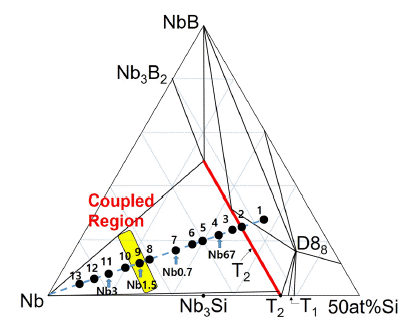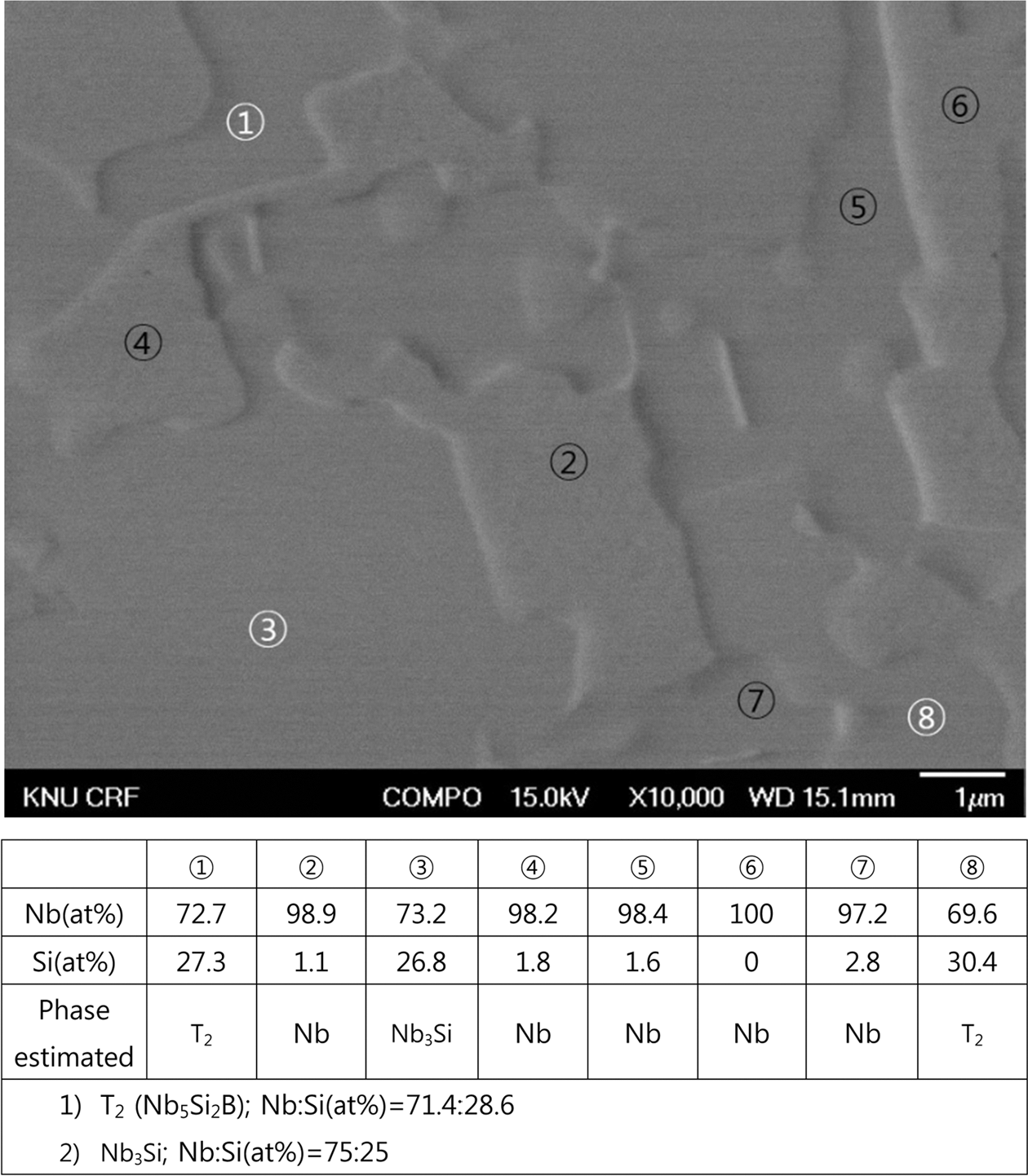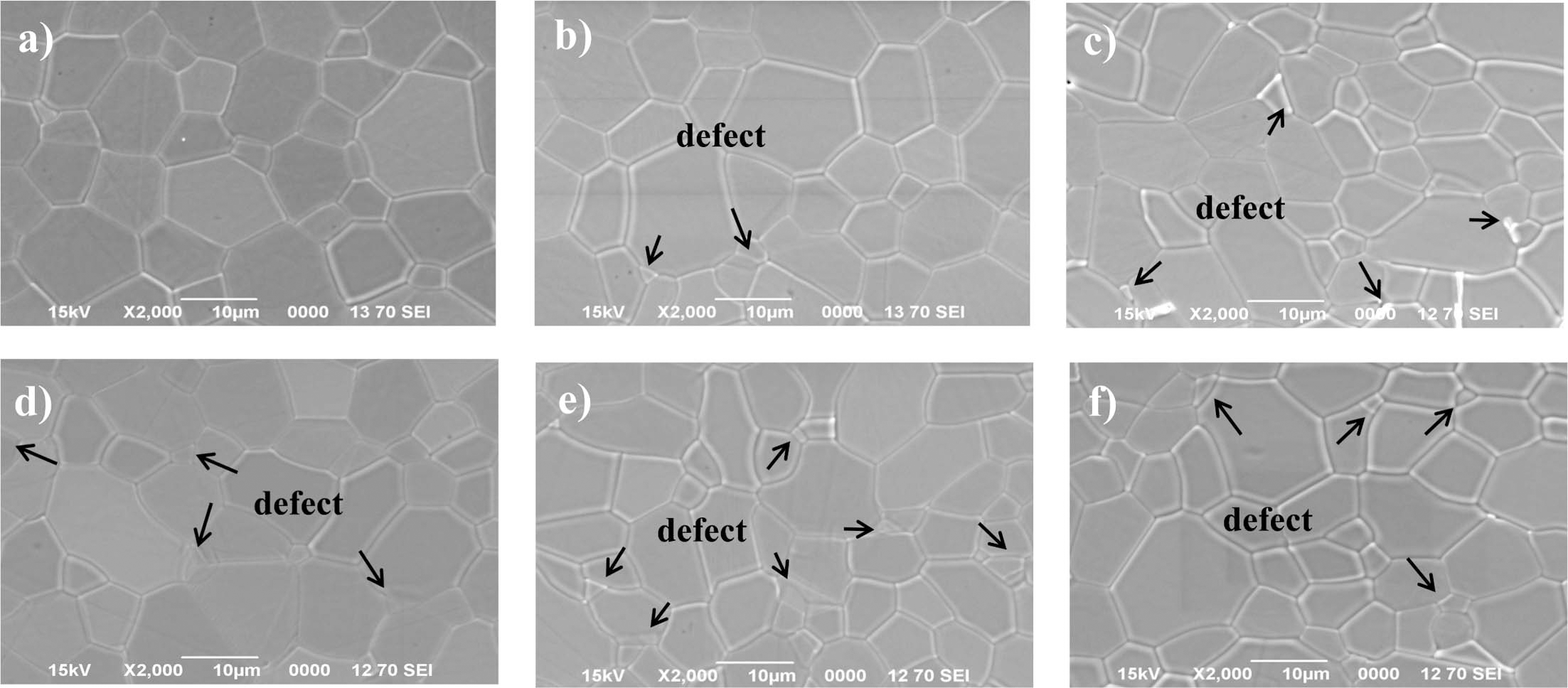Search
- Page Path
- HOME > Search
- [Korean]
- Fabrication of Nb-Si-B Alloys Using the Pulverized Nb-T2 Alloy Powder
- Min-Ho Cho, Sung-Jun Kim, Hyun-Ji Kang, Sung-Tag Oh, Young Do Kim, Seong Lee, Myung Jin Suk
- J Korean Powder Metall Inst. 2019;26(4):299-304. Published online August 1, 2019
- DOI: https://doi.org/10.4150/KPMI.2019.26.4.299

- 664 View
- 5 Download
-
 Abstract
Abstract
 PDF
PDF Nb-Si-B alloys with Nb-rich compositions are fabricated by spark plasma sintering for high-temperature structural applications. Three compositions are selected: 75 at% Nb (Nb0.7), 82 at% Nb (Nb1.5), and 88 at% Nb (Nb3), the atomic ratio of Si to B being 2. The microstructures of the prepared alloys are composed of Nb and T2 phases. The T2 phase is an intermetallic compound with a stoichiometry of Nb5Si3-xBx (0 ≤ x ≤ 2). In some previous studies, Nb-Si-B alloys have been prepared by spark plasma sintering (SPS) using Nb and T2 powders (SPS 1). In the present work, the same alloys are prepared by the SPS process (SPS 2) using Nb powders and hypereutectic alloy powders with composition 67at%Nb-22at%Si-11at%B (Nb67). The Nb67 alloy powders comprise T2 and eutectic (T2 + Nb) phases. The microstructures and hardness of the samples prepared in the present work have been compared with those previously reported; the samples prepared in this study exhibit finer and more uniform microstructures and higher hardness.
- [Korean]
- Microstructure Characterization of Nb-Si-B alloys Prepared by Spark Plasma Sintering Process
- Sang-Hwan Kim, Nam-Woo Kim, Young-Keun Jeong, Sung-Tag Oh, Young Do Kim, Seong Lee, Myung Jin Suk
- J Korean Powder Metall Inst. 2015;22(6):426-431. Published online December 1, 2015
- DOI: https://doi.org/10.4150/KPMI.2015.22.6.426

- 754 View
- 3 Download
- 5 Citations
-
 Abstract
Abstract
 PDF
PDF Microstructural examination of the Nb-Si-B alloys at Nb-rich compositions is performed. The Nb-rich corner of the Nb-Si-B system is favorable in that the constituent phases are Nb (ductile and tough phase with high melting temperature) and T2 phase (very hard intermetallic compound with favorable oxidation resistance) which are good combination for high temperature structural materials. The samples containing compositions near Nb-rich corner of the Nb- Si-B ternary system are prepared by spark plasma sintering (SPS) process using T2 and Nb powders. T2 bulk phase is made in arc furnace by melting the Nb slug and the Si-B powder compact. The T2 bulk phase was subsequently ballmilled to powders. SPS is performed at 1300°C and 1400°C, depending on the composition, under 30 MPa for 600s, to produce disc-shaped specimen with 15 mm in diameter and 3 mm high. Hardness tests (Rockwell A-scale and micro Vickers) are carried out to estimate the mechanical property.
-
Citations
Citations to this article as recorded by- Fabrication of Nb-Si-B Alloys Using the Pulverized Nb-T2 Alloy Powder
Min-Ho Cho, Sung-Jun Kim, Hyun-Ji Kang, Sung-Tag Oh, Young Do Kim, Seong Lee, Myung Jin Suk
Journal of Korean Powder Metallurgy Institute.2019; 26(4): 299. CrossRef - Mechanical properties of Mo-Nb-Si-B quaternary alloy fabricated by powder metallurgical method
Jong Min Byun, Su-Ryong Bang, Se Hoon Kim, Won June Choi, Young Do Kim
International Journal of Refractory Metals and Hard Materials.2017; 65: 14. CrossRef - Mechanical properties of Mo-Si-B alloys fabricated by using core-shell powder with dispersion of yttria nanoparticles
Jong Min Byun, Su-Ryong Bang, Won June Choi, Min Sang Kim, Goo Won Noh, Young Do Kim
Metals and Materials International.2017; 23(1): 170. CrossRef - Fabrication of Ta2O5 Dispersion-Strengthened Mo-Si-B Alloy by Powder Metallurgical Method
Jong Min Byun, Won June Choi, Su-Ryong Bang, Chun Woong Park, Young Do Kim
JOM.2017; 69(4): 683. CrossRef - Rapid consolidation of nanostuctured WC-FeAl3 by pulsed current activated heating and its mechanical properties
In-Jin Shon, Seok-Jae Lee
International Journal of Refractory Metals and Hard Materials.2017; 65: 69. CrossRef
- Fabrication of Nb-Si-B Alloys Using the Pulverized Nb-T2 Alloy Powder
- [English]
- Powder Injection Molding of Translucent Alumina using Supercritical Fluid Debinding
- Hyung Soo Kim, Jong Min Byun, Myung Jin Suk, Young Do Kim
- J Korean Powder Metall Inst. 2014;21(6):407-414. Published online December 1, 2014
- DOI: https://doi.org/10.4150/KPMI.2014.21.6.407

- 750 View
- 1 Download
- 1 Citations
-
 Abstract
Abstract
 PDF
PDF The powder injection molding process having advantages in manufacturing three-dimensional precision parts essentially requires a debinding process before sintering to remove the binders used for preparing feedstock. In this study, powder injection molding of translucent alumina was performed, and carbon dioxide (CO2) is used as a supercritical fluid that makes it possible to remove a large amount of binder, which is paraffin wax. The relationship between the optical property of translucent alumina and the debinding condition (temperature and pressure) of supercritical CO2 was investigated. As temperature and pressure increased, extraction rate of the binder showed rising tendency and average grain size after sintering process was relatively fine. On the other hand, optical transmittance was reduced. As a result, the debinding condition at 50° and 20 MPa that represents the lowest extraction rate, 8.19 × 10−3 m2/sec, corresponds to the largest grain size of 14.7 μm and the highest optical transmittance of 45.2%.
-
Citations
Citations to this article as recorded by- Experimental and numerical analysis of effects of supercritical carbon dioxide debinding on Inconel 718 MIM components
Dugauguez Olivier, Agne Aboubabky, Jimenez-Morales Antonia, Torralba José Manuel, Barriere Thierry
Powder Technology.2019; 355: 57. CrossRef
- Experimental and numerical analysis of effects of supercritical carbon dioxide debinding on Inconel 718 MIM components
TOP
 KPMI
KPMI


 First
First Prev
Prev


